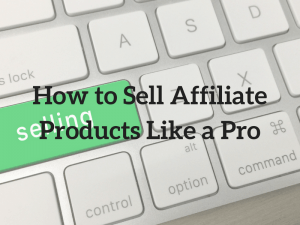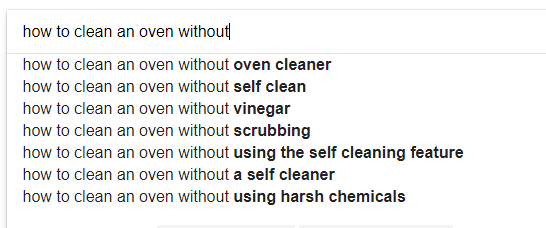 If you have a blog, chances are, you are also an affiliate marketer and sometimes, with all those content, it’s tricky for readers to pick out what you are trying to promote. Likewise, over promoting can also drive them away, resulting in poor conversion. So, how exactly do you sell affiliate products on your site without looking like a salesperson, yet still generate long term income?
If you have a blog, chances are, you are also an affiliate marketer and sometimes, with all those content, it’s tricky for readers to pick out what you are trying to promote. Likewise, over promoting can also drive them away, resulting in poor conversion. So, how exactly do you sell affiliate products on your site without looking like a salesperson, yet still generate long term income?
Here are some eye-opening tips that you may not have thought of.
1 – Write Thorough Product Review(s)
Product reviews are our bread and butter and it should be where most of the affiliate links reside. More so, it serves to educate a customer everything specifically, practical facts about a product before they make the purchase online. As a reviewer, it’s important to deliver this information as authentic as possible. Meaning that, it should be coming from your own experience and not from the merchant or someone else.
A thorough review should reflect your in-depth knowledge in a certain niche, covering both the benefits and drawbacks of specific goods or services. It should also prompt discussion and comments from people who have purchased or thinking of doing so. This social proof will boost the product’s credibility, transparency and most importantly, the trust factor that will eventually lead people to buy.
Using a specific plugin like WP Product Review, can help to customize a review post that clearly shows the pros and cons, the ratings and also generate a rich snippet that could potentially earn you a visible spot on the search engine result page.

As you can see, this type of structure is more engaging and easier to read, but it doesn’t always apply to all types of products. What’s actually more important is the keyword selection and getting your affiliate links to convert through a strong call-to-action on that page. There are a few phrase style – as I like to call it – that is usually used to represent reviews and I am sure you have seen them before.
For example;
- Brand + review (i.e. Samsung Galaxy S8 Review)
- Brand + Pro and Cons (i.e. Nike Flynit Pros and Cons)
- Unboxing the + Brand (i.e. Unboxing Dji Mavic Air)
- Is ‘Brand’ Worth It (i.e. Is Clickbank University Worth It)
But using these keywords as they are could sound a bit boring, so I would recommend adding another catchy phrase after that, in order to encourage more click through. For example, the title “Kindle Paperwhite Review – Why You Should Get One” is way more interesting than its original form. You get the idea, but if you need more help with creative words, head over to Portent Title Maker for some ideas.
2 – Compare Products
Every product has its own match in the same vertical market. From running shoes to robotic vacuum cleaner, it’s common to have more than one brand to choose from. And that’s what frustrates consumers sometimes – which one should they buy? Here’s where you can leverage by writing product comparison.
Such post benefits visitors in making a purchasing decision. It can either be product centric, meaning that you compare between brands or feature centric, which tells the difference between specific features.
Often times, this is done between two products, but with more selection in the market, consumers are now seeking for in-depth research across multiple brands. In such cases, you can create a product table (TablePress is a good plugin for this) and rate them in a way that clearly shows which is the actual winner
Just like the main product review, your keyword selection is important here and the common phrase styles to choose from are;
- Brand vs Brand (i.e. WordPress vs Squarespace)
- Top Number Products (i.e. Top 10 Vacuum Cleaner for Car)
- Number Best Products (i.e. 12 Best Bookstore Affiliate Programs)
- Number Must Have Products (i.e. 6 Must Have Makeup Brushes)
While it may seem exhaustive, product comparisons is extremely helpful in showing readers the bigger picture, the alternatives and which product will suit them best, based on their needs. Basically, you are taking away all the thinking job and that says a lot about your credibility as a reviewer.
3 – Create How-To Posts
This is probably one of the most favorite formats for promoting affiliate products on a niche site because consumers search the internet frequently to learn how to use a certain product. In writing such articles, you are providing immense values for people to become better at something, and better yet, they are your targeted audience who are already at the end of the consumer purchase cycle.
The only problem is, such articles are over-saturated and frequently dominated by more established sites like Wiki-How or magazine sites. So in order to stand out with your new blog, don’t write stuff that most people already know.
Instead, find new ways to do a certain thing that may interest your audience – maybe something that can help them save time and money or something that can be executed in a less complicated manner – these are ideas that can potentially give your how-to posts a new twist.
When looking for keyword variation, such post can actually become the main product review itself. Google Suggest is a great place to discover trending how-to phrases and one good tip is to go for as long tail as you can – meaning, choose descriptive keywords.
While brainstorming for ‘how to clean an oven’ for example, I found that people are also searching for other alternatives such as the following.

And when I cross check one of those keywords with my favorite keyword tool, I found a gem that has a low competition level (QSR less than 100).

Some people say that how-to articles are outdated, but I am in the opinion that, if you do your research and discover them early in the trend, you can totally leverage from these keywords, especially with a new blog.
4 – Highlight Featured Posts
The good thing about using WordPress as a blog is the ability to customize it to what you want the readers to see when they visit your site. Wouldn’t it be great if your product reviews or popular How-To posts are noticeable from the get-go? Well, there’s a solution for that and it’s called Featured Posts.
This feature basically highlights a snippet of content on the blog, but it’s not a standard or a default function that one would get out of the box. Some people use special plugins to activate the feature and others install codes. If you don’t want to deal with those, then it’s best to get a theme that comes with the ‘Featured Posts’ function.

For example, in the Genesis framework, this feature can be found under Appearance => Widget. From there, you just need to move the widget to the desired menu location, fill out the necessary information and the featured section will appear on the site.
5 – Leverage From Image Links
A picture is worth a thousand words and this couldn’t be more helpful, especially when you want to attract readers to click on a link. By now, each of your product reviews or How-To posts should have at least a featured image so that you can use it on the featured widget.
Other images to consider are actually banners and coupons that are provided through your affiliate programs. They can be used to promote a particular product, a merchant or an offer during seasonal shopping time. In most cases, they are embedded among the text inside posts, at the end of the articles or on the sidebar menu.
The best location is very much dependant on how you want to funnel the readers. Whatever you do, just remember to use them sparingly and avoid making your blog look like it’s being peppered with advertisements all over. They are distractive in that sense and could potentially drive visitors away.
Salesy images simply make people immune nowadays, so plan strategically and try to maintain a clean and professional look on your site all the time.
6 – Create a Resource Page
If you are promoting mostly digital products or service subscriptions, it’s a good idea to comply them in a list and publish on what is called a Resource Page. This page can be placed in one of the menu navigations to make it visible or used as an incentive to create an email list. Inside, is where you would point readers to your product reviews or you could also apply affiliate links and lead them directly to the merchant sites.
7 – Create an Affiliate Store
For those who are promoting multiple physical products, even from different merchants, why not create an affiliate store for the convenience of the readers to browse through your recommendations? These products are usually connected to affiliate links and when clicked, they would direct readers to the merchants’ eCommerce sites for purchase.
To create this, you will need to install and setup WooCommerce plugin which is free to use for the basic features. Once the store is organized, you can place the store link on the main navigation menu where it is visible for anyone to see.
8 – Create YouTube Videos
For those who are interested in video making, you can use YouTube for product reviews or How-To tutorials in addition to writing articles. If you optimize the videos with targeted keywords, it could potentially attract a lot of traffic from this search engine. The common practice here is to include affiliate links in the video description (not on the video itself) or point it to a product review article on your blog.
Likewise, you can also embed YouTube videos on your blog to increase user engagement time and boost rankings or when permission is granted, you may also use other people’s videos to complement your topic.
What’s Your Favorite Conversion Method?
I hope you’ve discovered some interesting ways to promote affiliate products on your site. It may not necessarily apply to all types of niche blog so I encourage you to explore each option and see what works best for you. Meanwhile, if you have some time, please check out my recommended affiliate platform for more in-depth training on what I’ve just covered. It’s a robust community of entrepreneurs and I am sure you’ll benefit a lot from it.

Good article with useful ideas. I have used some of these methods, but the affiliate store sounds like an excellent idea. I will give that a try. Do you have maybe an example of that? I would like to see how it actually looks. Definitely a helpful post and thank you for sharing.
Hi Wei, if you visit The Minimalist Baker website and look under her ‘Shop’ (you’ll find it at the main menu navigation on the top), you’ll see a listing of products on that page. When you click on the ‘Buy Now’ link, it will take you directly to the merchant that she’s affiliated with.
That is one good example of an optimized affiliate store vs one that just upload a bunch of products with very little to no content like the Fresh Store Instant builder.
Hey Cathy,
This is a very insightful article. l am fairly new to affiliate marketing business and still struggling with traffic and conversation. I would try to explore some of the options mentioned and see what works for me.
Question – do l have to own and use the products before promoting them? Or is thorough research sufficient enough? Thanks for the input.
Hi Shui Hyen, you don’t always necessary have to own a product in order to write a review. There are ethical and legitimate ways to go about it and here’s a link tutorial to guide you through. Hope it helps.
The comprehensive information you’ve put across here not only shows how knowledgeable you are in the make-money-online world, but how you really care about helping people. I will call myself a newbie in affiliate marketing and I can relate to how I struggle constantly, trying not to sound like a salesperson in my product reviews.
You’ve provided some great tips, which I will start implementing right away to help me deal with my sales pitch issue. I like the way your blog is organized. Thanks for the info.
Hi Cathy, very good and informative post about selling affiliate products, I think everyone of us who are dealing with this, sometimes ask ourselves how to do it. You described this very well and I think this is a must read for beginners and also for others. Have you been doing online business for a long time? Thanks for sharing.
Hi Luke, I’ve been doing this for 4 years now and it’s only the beginning. With new technology emerging each year, there will be more ways to promote affiliate products in the near future and I’ll be sharing more of these in the coming posts.
This article is a must-read for every aspiring affiliate marketer out there as it contains some really valuable information. The hardest part about promoting products literally is to make sales without looking like a salesperson. This is what I’m currently struggling with, but this article shed some light on how it has to be done. Thank you for sharing.
I get that a lot too, Ruya. I guess the more you put yourself in the reader’s shoe, the more natural your content will sound. Try different writing styles and also read other blogs that are similar to yours – pick up the elements that you like and emulate that through your own articles.
My wife and I recently decided to make a go of the online business venture. You make it sound so much easier than so many other sites we have visited. You have been at this for quite some time, I see. Do you recommend doing videos? I only ask because I am kind of camera shy and my wife knows virtually nothing about technology .
The rest of the aspects sound doable enough – just the video part seems a bit daunting. Do you recommend any particular video software or ways to avoid being the “face” of the video?
If going in front of the camera is something daunting, then don’t do it just yet. Video is just a complementary to textual content such as blogs and many people do well even without implementing any video marketing. There are plenty of professional video software in the market – just Google them and compare their prices/features to see which one is suitable. Otherwise, you can also try the animated ones like Animaker whereby your presence can be avoided in the clip.
Hope this helps.